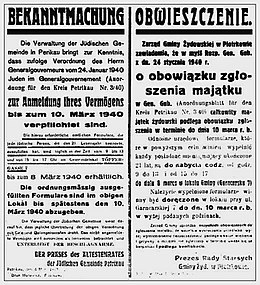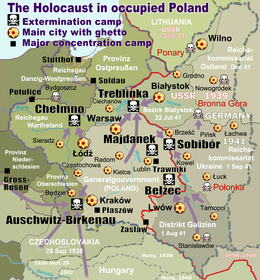Piotrków Trybunalski Ghetto
| Piotrków Trybunalski Ghetto | |
|---|---|

Ghetto announcement, 24 January 1940
at Piotrków Trybunalski |
|
| Location |
Piotrków Trybunalski, German-occupied Poland 51°24′34″N 19°42′06″E / 51.409566°N 19.701608°ECoordinates: 51°24′34″N 19°42′06″E / 51.409566°N 19.701608°E |
| Incident type | Imprisonment, forced labor, starvation |
| Organizations | Schutzstaffel (SS) |
| Camp | Treblinka, Majdanek |
| Victims | 28,000 Polish Jews |
The Piotrków Trybunalski Ghetto (Yiddish: פּיִעטריקאָװ) was created in Piotrków Trybunalski only 38 days after the 1939 Nazi German Invasion of Poland in World War II. It was the first Jewish ghetto in Nazi-occupied Europe, founded on October 8, 1939, on the general orders of Reinhard Heydrich. After a battle with the Polish Army resulting in heavy devastation, the town was occupied by the Wehrmacht on September 5, 1939. Piotrków was made into a county seat (Kreis) of the newly created Łódź District (Regierungsbezirk Litzmannstadt) of the German territory of Reichsgau Wartheland. It was put under the command of Hans Drexler, an appointed Nazi Oberbürgermeister who also created the Ghetto. In total, some 16,500–25,000 (up to 28,000) Jews went through the Piotrków Ghetto which was liquidated beginning 14 October 1942 in four days of deportations to Treblinka and Majdanek extermination camps aboard overcrowded Holocaust trains.
The Piotrków Ghetto was the first wartime ghetto of its kind. Set up in one of Poland's oldest cities with a thriving Jewish community, it took until late January 1940 for the new inmates to move into it. First, the Judenrat was established and ordered to issue an announcement about the relocation, but this had no effect. Consequently, the Germans themselves evicted the Jews from their homes, transferring them to the ghetto by force. Eventually, up to 28,000 Jews were squeezed into a part of town where only 6,000 people previously lived. The homes vacated by the Jews were assigned to Christians and members of the German minority who took over their businesses after the relocation. It was an open type ghetto –- an early variant of Nazi ghettoization -– without the barbed wire fences introduced later throughout all of occupied Poland. Only warning signs with skulls were placed along the boundaries, and the main gate erected. The ghetto was pronounced closed from the outside on October 28, 1939.
...
Wikipedia


